
29 minute read
UKRAINE OVERVIEW - GEORGE GITTOES
STARTING TO BE ABLE TO WRITE UP THE WHOLE UKRAINE EXPERIENCE INCLUDING THE MOST RECENT WORK JUST COMPLETED.
Photographers and filmmakers call the last hour of sunlight in the afternoon the ‘magic hour’ because colours glow with their fullest intensity and are no longer washed out by the intensity of reflected sunlight. It is the same in mid-winter when the sun is at a low angle all day.
People caught up in a war are like the flowers that glow brighter yellows and pinks in low light. There is a human warmth and brightness of spirit that emanates from all Ukrainians after suffering over a year of war, never knowing when days on Earth will be ended by a bullet, missile or a nuclear bomb. This insecurity is expressed by the artists. Putin has moved tactical nuclear weapons to Belarus. These are Doomsday weapons, some of which are one hundred kilotons, many times more destructive than the bomb dropped on Hiroshima in 1945 which was 15 Kilotons. Images of nuclear death now dominate the drawings of Ave and are made more urgent and fragile by her baby daughter, Penelope, born after twelve months of war. (see pics)
Hellen and I are committed to keep returning to Ukraine aware that a nuclear attack is firmly on the cards.
In late February 2022 we had just returned from Peshawar in Pakistan and were working on editing video footage from Afghan Yellow House Project when the news of the Russian Invasion came out. Our plan was to return to Afghanistan and make a film about the impact of the American withdrawal and our hope that the Yellow House could continue under their rule. We had been in Pakistan to established what we called a Yellow Submarine for our Yellow House Artists and filmmakers to be able to continue working during the early, turbulent days of the Taliban Takeover. A safe haven for artists who were feeling insecure about how they would be treated by the Taliban. We all worked together to shoot a film remake of Charlie Chaplin’s GREAT DICTATOR and were editing it. We were focused on the news of Afghanistan when the Russian invasion of Ukraine supplanted it as the dominant story. It seemed to us that the chaotic and disastrously poorly planned exodus of US Forces from Afghanistan, enabling the rapid retake of control by the Taliban, had emboldened Putin to make his move on Ukraine.
Putin judged the Biden administration and US military as weak and incapable of reacting to a Russian offensive. The world had hoped that after WW II and Bosnia, there would never be another major war on European soil. The nuclear deterrent was supposed to prevent this and the stand off between Russia and NATO throughout the cold war seemed to make this unlikely. Again humanity was on the brink of a world war. There was no question, I had to be there with the Ukraine people, on the ground facing whatever eventuated. Hellen and I made the instant decision to travel to Kyiv in the first week after the invasion. At the time the media were predicting the long convoys of Russian Tanks and soldiers would be able to take the city within days.
We got to the border at Przyemysl only to find out that trains into Ukraine had been cancelled. The station was filled with refugees, mainly women, children and seniors along with pets in carry cages. I made my first drawings showing the despair and fatigue on their faces. I had an instinct we could still travel and went exploring outside the station. I found a country train that was on a separate line to the main rail. We were able to board it, late at night . There was a moment as we bordered when we realised there was no turning back if we got on and we felt fear in the pit of our stomachs. This train was almost empty and took us to L’viv where we caught a bigger train into Kyiv. We knew nobody there.
Hellen had booked a hotel which was next to Maidan. We wanted to be near Maidan as we knew the history of how this is where the people’s revolution for Independence from Russia occurred in 2013. We were the only guests in the hotel and the city was deserted with no one moving outside and limited food supplies available from a small underground supermarket. There were tank traps on every corner and young soldier guarding them. We made friends with these soldiers who readily told us that they were not regular army but many other professions from IT programmers to civil engineers. It was mid-winter with some snow. Hellen would send me down to them with hot soup and coffee. We imagined that any day there would be Russian tanks and street fighting similar to what we have seen in old black and white archival footage from WW ll.
I have not previously been to Ukraine, nor has Hellen. I was in Sarajevo during the Bosnian war which had many similarities. We have just returned from our second period in Ukraine and intend to keep returning while ever the war continues.

First Time In Ukraine
Neither of us new much of Ukraine history or geography and had no contacts to assist us on arrival. We knew we would have to improvise every step of the way, at first.
The House of Culture in Irpin was one of the first cultural institutions to be targeted in the early days of the invasion. It was hit by multiple rocket attacks, tank rounds and mortars. Putin wants to deny that Ukraine has its own independent culture and is attempting to erase cultural centres throughout the country. We knew of this and made it our priority to go there as soon as the Russians began retreating and immediately began to contact our Ukrainian artist friends to prepare exhibitions and performances within the ruins. We aimed to prove the spirit of art cannot be suppressed by such barbarity.
For the two last decades I have been disappointed to see how little Australians know of art and cultural history. Graduates from Art Schools and Art and Media courses at University come out with little knowledge of art history. It makes it very difficult to talk to them about painting without going to my library and showing them examples like Otto Dix, Francis Bacon and Chaim Soutine - along with Modigliani, Klee and others. They eat these books up but have not been introduced to them when doing their studies. The opposite is the case in Ukraine - the knowledge of cultural history is universal there.
Taxi drivers and tradespeople know who I am referring to and often begin by looking at my work and then referencing Otto Dix and Kath Kollwitz and others without my prompting or contributing. Professional soldiers on the level of Commanders have a similar but more detailed knowledge of the arts than most others.
In Australia I would not even expect a General to have any knowledge of this kind. It is refreshing to be immersed in a culture that understands and appreciates arts.
I was expecting to have to explain our 'Kiss of Death' mural to the locals around Irpin and was both amazed and relieved when they immediately said "Guernica" and no further discussion was needed. They would say "Guernica" and then ask whether we needed anything like food or a cup of tea/coffee.


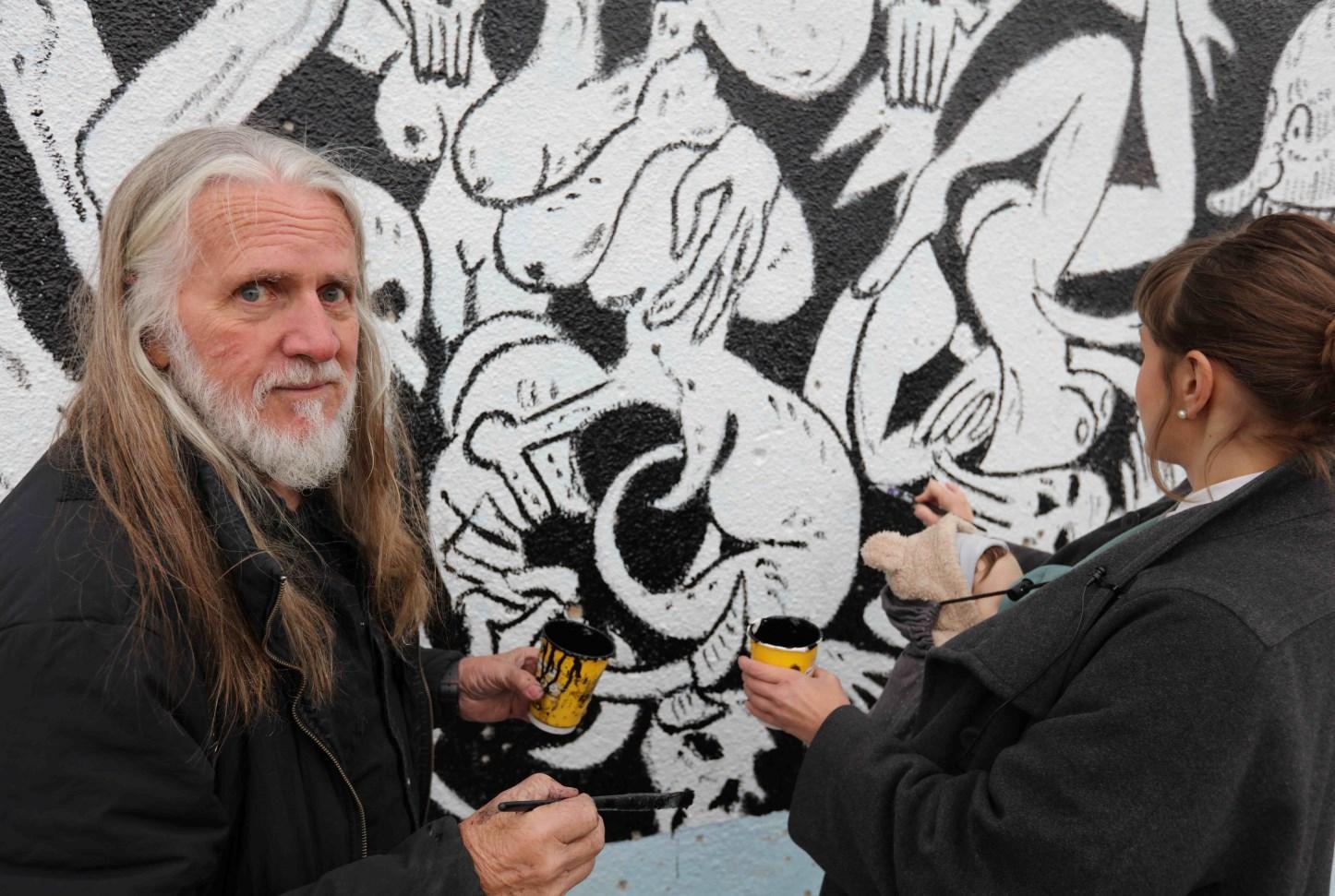






Kiss Of Death Mural And Collaboration With Ave
Every day since the moment of my first meeting with Ukraine artist Ave Libertateamor we have created a new drawing and shared them via the internet or in person. (Ave uses a false name like Banksy and hides her face from cameras in order not to reveal her true identity)
The ‘Kiss of Death’ mural was to be a high point in the collaboration with Ave. We wanted to take our series of drawings outside on a large scale so that the locals could feel that art was coming back like a phoenix out of the destruction.
Ave and I struggled for weeks to make an entirely new composition but could not arrive at anything we were happy with. One night I stayed up for many hours juggling works we had created together in our FLEXIBLE WOMAN series.
My WARHOUSE drawing worked in the centre with Ave’s ‘Flexible Woman’ drawings on either side plus a few added smaller elements to bind the images. The right-side image by Ave had to be flipped. I sent a photo of the result to Ave the following day and she replied that she was delighted with it. It was a relief to get something so intrinsic to our work together that melded, and we felt totally happy with it and titled it ‘Kiss of Death’. The young artist team of Sasha Kirikhov, Artem and Marycia Prus Rudenkko helped me to paint most of it onto the wall of House of Culture. It took a night and two long days using industrial quality enamel paint. People from the destroyed, surrounding houses came to watch and comment on our progress telling us that this was a good start to restoring things to the way they were. Ave joined us towards the end to improve the brush work and add detail on her sections.
‘Kiss of Death’ is in black and white, very graphic and similar in size and proportion to Guernica. The actual drawing, composition and figurative subject elements are nothing like Guernica, however, but we enjoy hearing the spontaneous reaction of viewers who saw the connection. Young people think it is very cool and the manufacturer of skateboards in Ukraine has asked for permission to put it on their decks. Recently Buses have begun bringing people to visit the most damaged war affected places. Since our murals and those by Banksy have been well publicised in Ukraine, the guides on the buses have made them a feature of the journey and stop off to see them including the others, we have done at Irpin Bridge, Borodyanka and Bear Mountain Park. It has become an extensive outdoor show of Gittoes, Ave and Banksy.
Unlike Guernica the subject is not explicitly showing distraught human and animals as the casualties of the bombardments. Since our painting is placed among the actual victims in the community of Irpin this would have been very disturbing and inappropriate. I doubt whether Picasso would have painted the same picture had he known it would be shown in Guernica and not the Spanish Pavilion of the World Fair. This war is the product of the megalomania and brutality of Putin. To normal people his actions are incomprehensible. His partnership with Alina Kabaeva is a soft point with Putin who has threatened journalists that they should never mention it. Alina is much younger than Putin and is referred to as the Most Flexible woman in Russia as she is an Olympic Medal Winning Rhythmic Gymnast and contortionist. The painting is a product of Ave and my meditation on his corrupt and twisted, psychopathic behaviour and his choice of a young contortionist as his sexual partner. And Alina is no innocent having been appointed by Putin to run the Kremlin’s suppressive media monopoly.
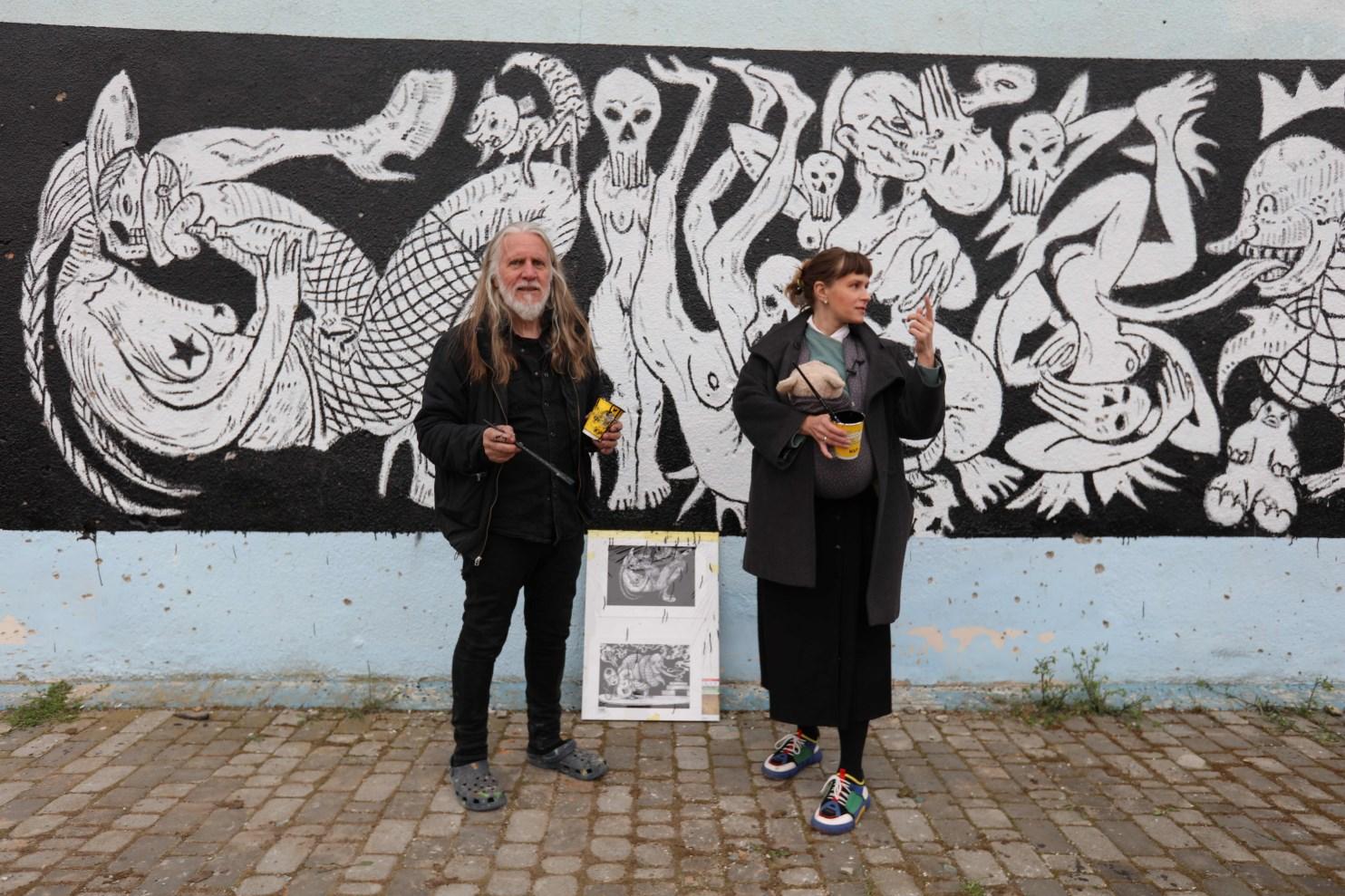
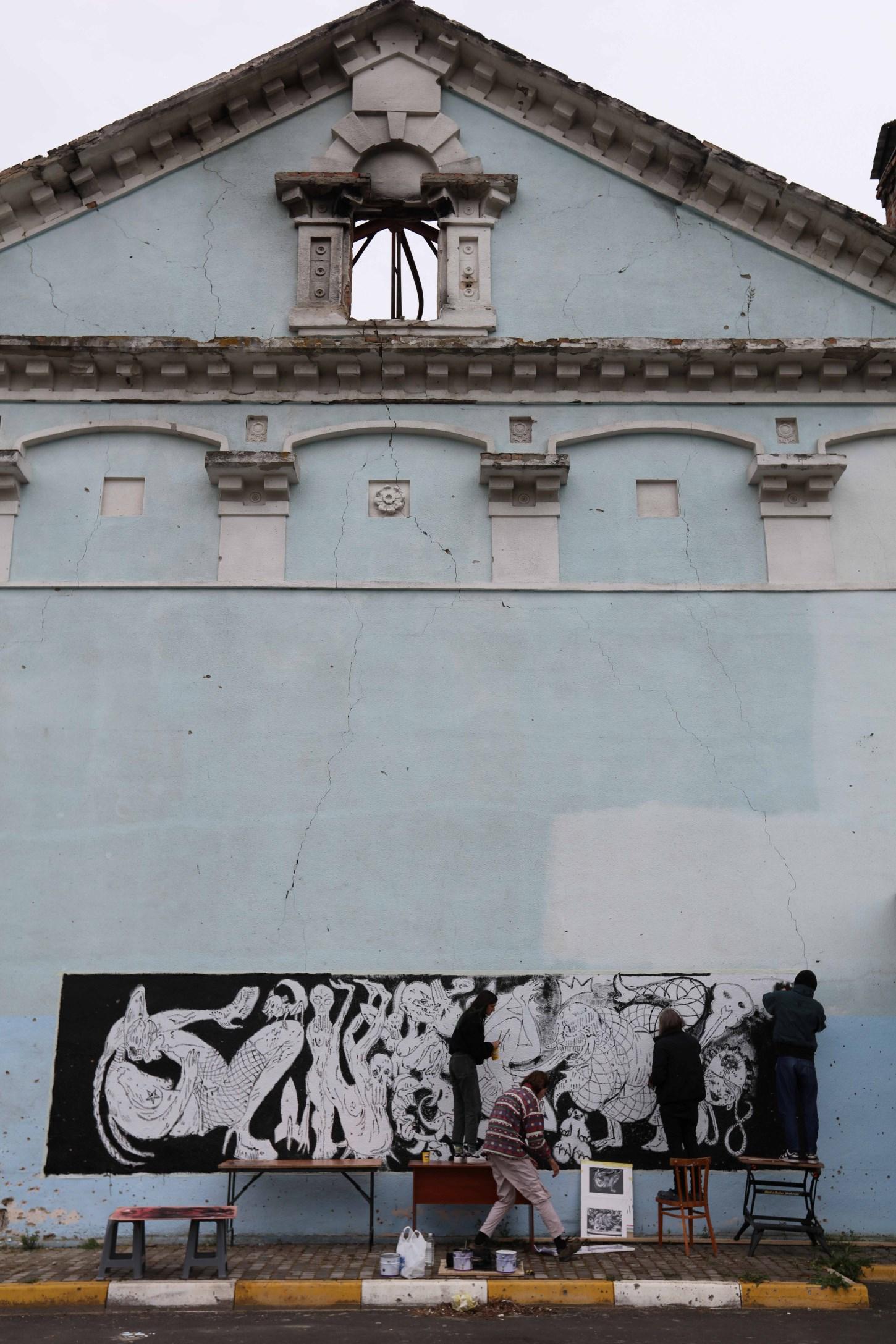

Odessa Collaboration On Dark Lord Outdoor Piece
The Hobbit and Lord of the Rings were showing on Ukraine Cable television (I think it was Netflix) at the start of the war making everyone see the comparison. Tolkein wrote those books at the time of Hitler’s Nazi assault on Europe – the comparison has had renewed life now that Putin is behaving similarly as a Dark Lord.
The plan to show Putin and the Russian Forces in this way was the Odessa Poet , Viktor Solodchuk’s idea and the mural is a visual realisation of a poem he had written in the first weeks of the war. Since then I have become cautious about making the comparison, especially comparing the Russia Soldiers to Orcs as this seems tasteless when many of the soldiers are forced into service against their will and brainwashed by Putin’s propaganda.

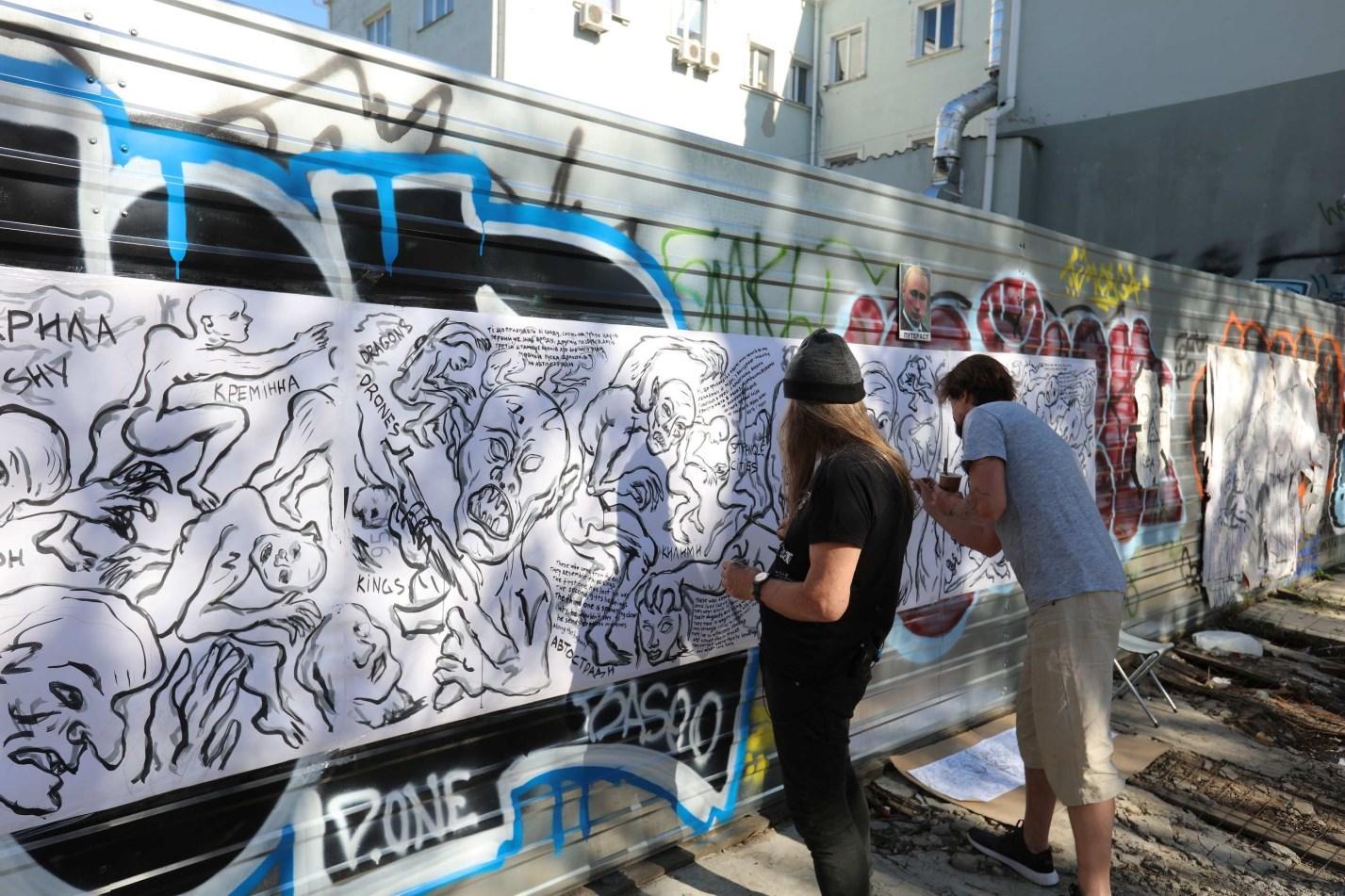
Yes, I do see Putin as a ‘Dark Lord’ but all my years of contact with soldiers informs me that many of the Russian soldiers would be innocents unaware of the motives of their superiors, especially Putin , and not in control of their own destinies. My painting ‘Dead Russian’ is a meditation on this. What I did take from that mural and the discussions with Viktor was the concept of the needle which is a well-known evil defeating symbol in Ukraine folk stories. The search for the needle is the search to find a way to defeat the ‘Dark Lord’ . Viktor explains this in the film and the theme was taken up in the drawings of Ave and myself. We like to think that art can be the needle. The symbolism of the needle bridges and joins the collaborations with Ave and Viktor.
Hellen used one of Viktor’s poems in her performance piece.
History Of Atrocity
Chance has placed me at the centre of some of the worst atrocities such as the Kibeho Massacre in Rwanda and the Hebron Massacre in Palestine. In Ukraine it was A) Borodyanka where we arrived as the Russians were retreating, the destroyed, B) Russian tanks at Bucha and C) the Bridge of Death in Irpin. The Russian soft toy bear, stuffed with explosives as a booby trap at Borodyanka, the small child’s party dress also at Borodyanka and the dead farmer and Punisher Palace on the outskirts of Borodyanka became a series of metaphors ….then the cars on the destroyed bridge at Irpin with families slaughtered, inside them. The destroyed interior of the House of Culture was, also, at Irpin and symbolised the barbarity of the Russian attack on and denial of Ukraine’s Independent Culture.
Ukraine Assistants And Collaborators
In the first period in Ukraine, it was Kate Purunova and Oleksandr Solodkyi. Both found me. Kate noticed Hellen’s posts on social media and contacted us wanting to be of assistance and Oleksandr (or Alex) met me when I was drawing the dead Russian in the tank at Bucha. He is an IT specialist, but his wife is an artist who fled with their daughter to Holland when the war started. Alex lives in Irpin and was keen to be part of the regeneration of the House of Culture. He assisted us with every aspect from the physical work of turning the place back into a workable environment to using the cameras for the film. He has been a great help in the second phase as well as the first.
Kate became our driver and second camera operator. She explains her role well in the film.
On the second phase we met Artem Rudenko and Marycia Prus (both are 26 year old artists and are girlfriend and boyfriend) at an art store when buying painting supplies. Artem volunteered to translate for me at the store and we immediately became friends. He wanted to introduce me to his closest friend and fellow artist Sasha Kirikhov. They immediately asked me to be a mentor and teacher and were invaluable in everything we did from camera operating to painting the big work at Irpin House of Art. They did not have a car, so we went everywhere together by Uber and Bolt. Kate was unable to work with us on the second lot of projects because she had found a full-time job. But, in her spare time she joined the team.
Artem, Sasha and Marysia were very critical of the fact that the only outdoor street art being done through the war was tagging with graffiti . Big spray paint names in different forms of bubble writing but nothing addressing the war. They wanted to get out and paint images about the war and how it feels but were too inhibited as fine artists to do this. By assisting me to do my wall paintings they lost this inhibition and were grateful for this. I worked beside them when they designed their first outdoor street paintings. Now they are out and about regularly doing more works like mine on walls in selected public places. They hope this will encourage more artists to come out and replace the Tagging Graffiti with relevant and powerful art.
Getting Started On Wall Painting
I was, initially inhibited myself. One day I found a sheet of cardboard from a collapsed box in the garbage and took it to my apartment and cut out an angel stencil. I put the guardian angel between graffiti tags, on the street wall outside our apartment building. I did it at night and worried about the police catching me, but a police car went by, noticed me, but did not stop. I assumed that seeing someone doing spray work was a common spectacle that did not worry them. This freed me up. My first large wall painting one was at Borodyanka. When I walked up to the building I had decided to do it on I was surprised to find a Banksy in an enclosed structure, which had been built around it, to protect it. The locals were angry that this had been done when they were homeless and sleeping rough without shelter. There was a red line inside. When I crossed it a very shrill alarm went off. A security firm had been commissioned to protect the Banksy works after a crew of thieves had cut one from a wall and were caught trying to take it away. It is now in bubble wrap in the Police Station. The other Banksy works, now, have strong metal frames placed over them with bullet proof glass protecting them. One is controversial as it is of an acrobatic gymnast identified with Russian culture and not Ukraine culture. It is ridiculed as depicting Alina Kabaeva but I am sure Banksy is innocently ignorant of this connection. People do, however, like the Banksy of a small child in Judo cloths throwing a grown man, also in Judo clothes, down back first. This was made into a stamp which was soon sold out as people purchased it to be able to sell on eBay to stamp collectors world-wide. I tried to buy one but there were no more left at the post office. It was the judo Banksy that was in the glass enclosure at Borodyanka. Our works have been well publicised on TV and local media in Ukraine so people go searching for them at the same time as searching for Banksy. It has become like a joint outdoor exhibition of Banksy and Gittoes/Ave.
Kate And How The Film Began
Kate is an animal lover and before she found us to work with, she was a volunteer in helping to save and feed the many pets that had been abandoned and were starving once their owners had fled as refugees. There were more homeless wandering dogs and cats in those early days, on the streets, than people. It was heart breaking. Organisations sprang up to help these pets survive and Kate was in contact with them. She heard that there were dogs in distress at a Dog Shelter in Borodyanka and got permission for us to join the group who were travelling there to see what help could be given. There was fighting still going on as we drove there, and it took over five hours to arrive in what is normally only a one hour trip. The rescuers belong to an organisation called STAR and were led by some British ex-soldiers who are dedicated to assisting animals. One of them, Tom, explained that animals were the best cure for the PTSD he suffered from fighting in Helmond Province of Afghanistan.
(There is a good interview with Tom in the film.) We were unaware that by joining the rescue we had travelled to Borodyanka before it has been totally liberated by Ukraine forces and ahead of the International Press. The devastation we witnessed in the city was heart-breaking. Being the first to arrive happened a lot while we were in Ukraine as we did not go to press conferences or seek the help of Ukrainian Official Press Organisers. Kate, being a local made this easy and possible. We stayed away from the International Journalist Press Core as we did not want to be influenced by their hype and agendas.
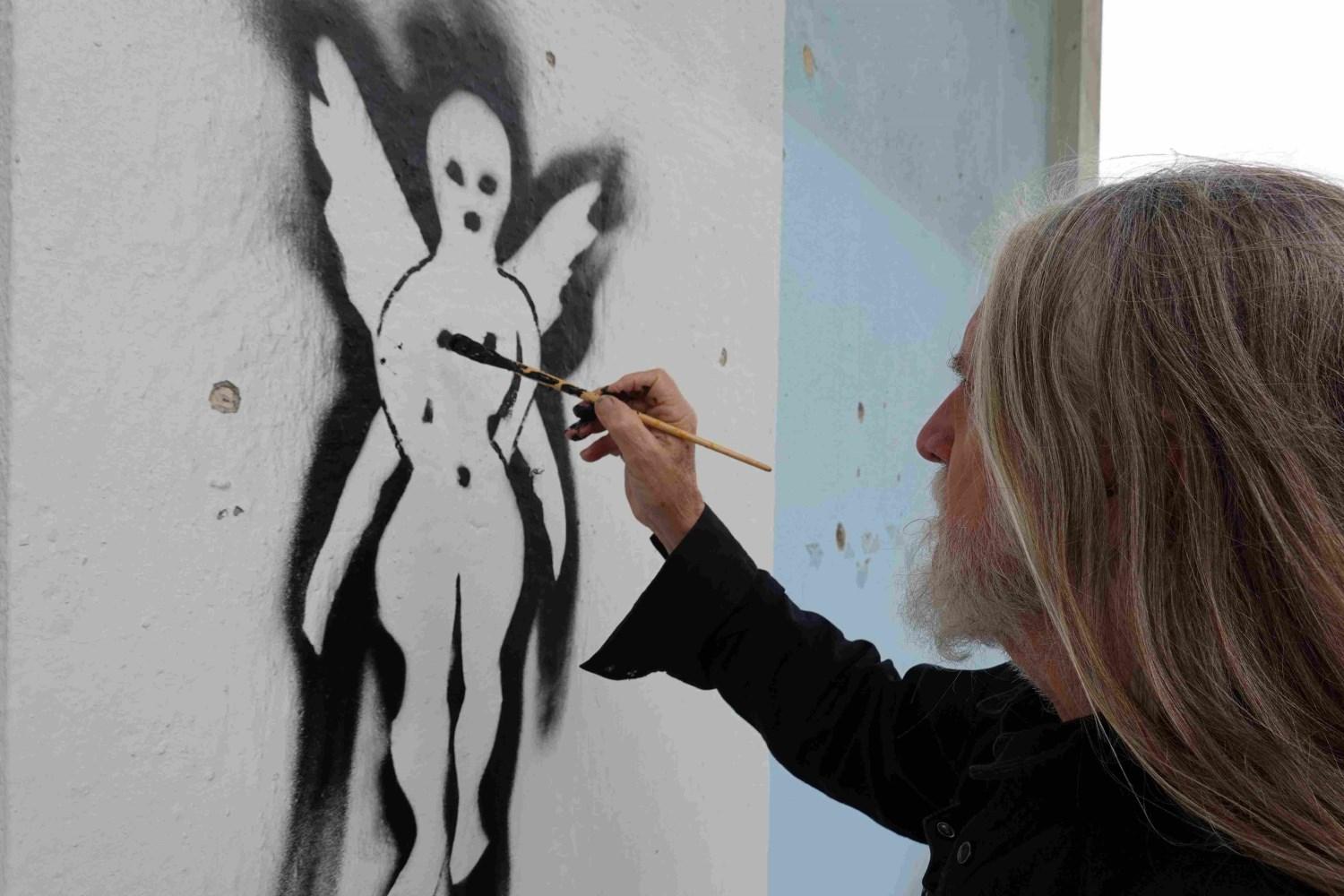
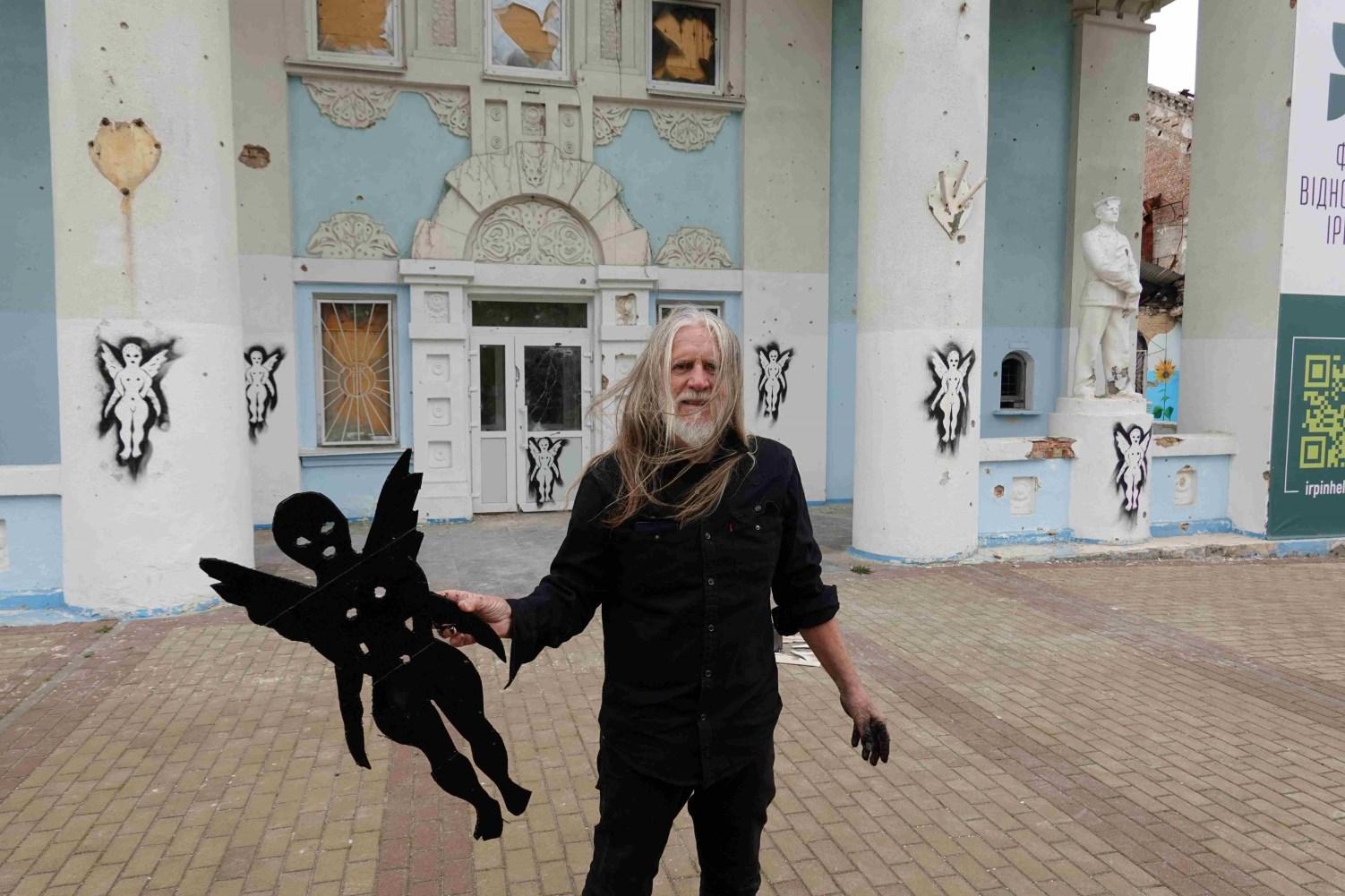

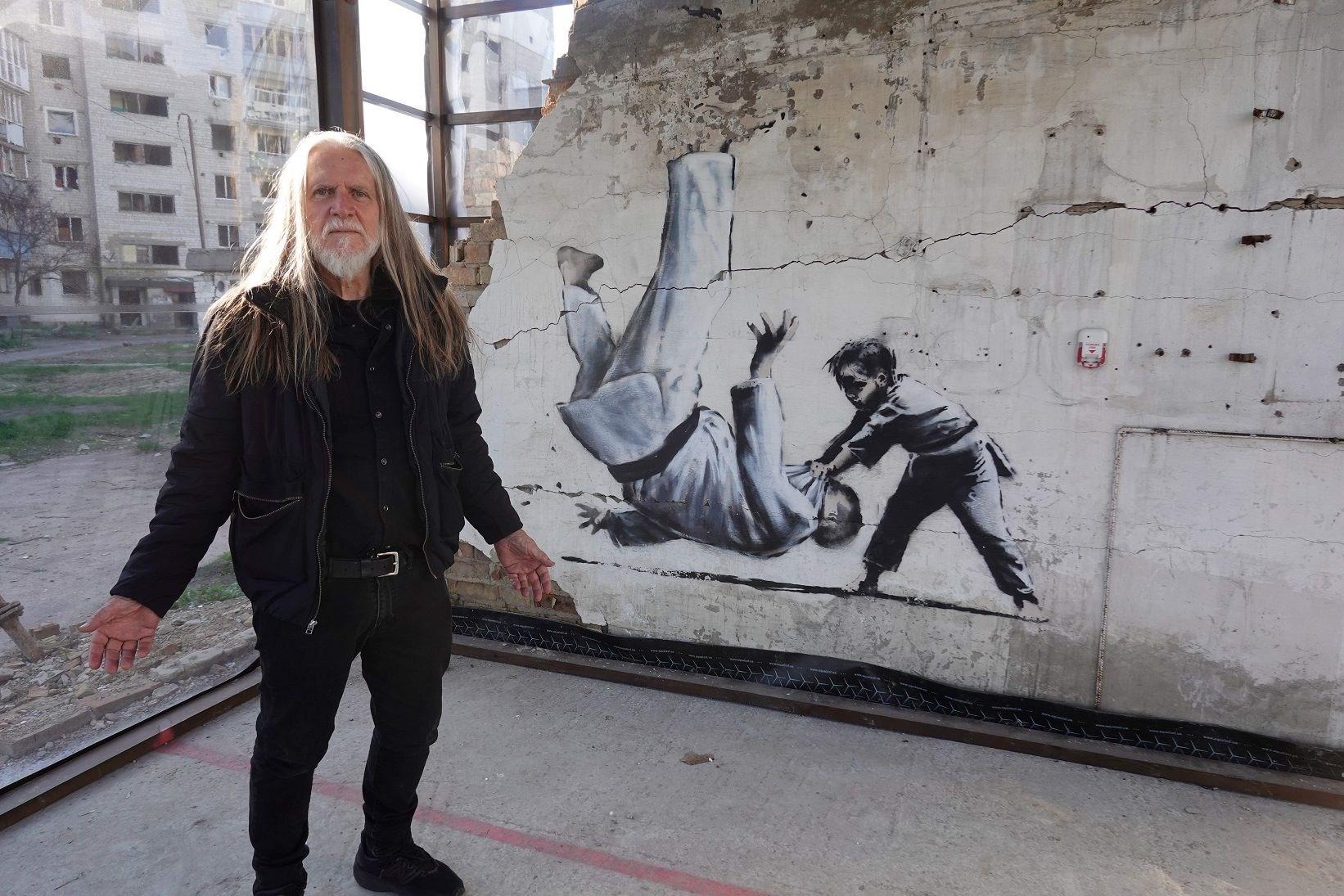
Access
Often, I would be in the car with Kate and I would have a dog or cat on my knee that needed saving and we would pull up at one of the many road blocks and not be asked for ID or passport because I looked like an eccentric old Ukrainian grandfather with his young niece or daughter saving a family pet. This enabled us to pass into areas where the press would not be allowed to enter. In the case of the Bridge of Death at Irpin we got there shortly after it had been destroyed and the people in the cars massacred, because Kate’s grandmother lived in Irpin and Kate and her mother had to help save her and get her out to Kyiv. Kate was assisting with the rescue of her grandmother; she heard about the massacre and took us to it. It was the first time Hellen had experienced wartime death on a large scale. It was particularly terrible seeing dead children and babies. I worried for her as it was such a traumatising experience. But Hellen came through it bravely and helped with the filming. My major painting ‘Bridge of Death’ which is on show at Queensland Art Gallery was based on this experience and I am still processing it in new art.
Accessibility
I always have the approach that art is difficult enough for people to understand without consciously making it more difficult. I use every means at my disposal to create bridges of understanding between the viewers and the art.
In Ukraine it was easy because my subjects, from the start, were of things that the people there were experiencing and sharing. The people of Irpin for example immediately understood the ‘Bridge of Death’ painting and the people of Borodyanka had all seen the Child’s Party Dress and knew how the parents had put it on the window to tell the Russians that children were inside and then a rocket was aimed, deliberately into their room. Same with the Russian Bear which was placed theatrically for everyone to see as a symbol of Russian Supremacy as they left the city in ruins. They boobytrapped the bear so that it would remain smirking defiantly until a squad of bomb disposal people could disarm it. People thanked me for doing the work and showing support from someone as far away as Australia. They did not feel forgotten or neglected by people in other countries due to our very visible presence and support. This is different to the way that people soon became annoyed and irritated by the international press who they began to see like vultures pecking at their wounds. We do not wear PRESS body armour or helmets and appear like any local civilian. This is highly appreciated. Plus, the act of creating, with me painting and Hellen singing opens people’s hearts to us.
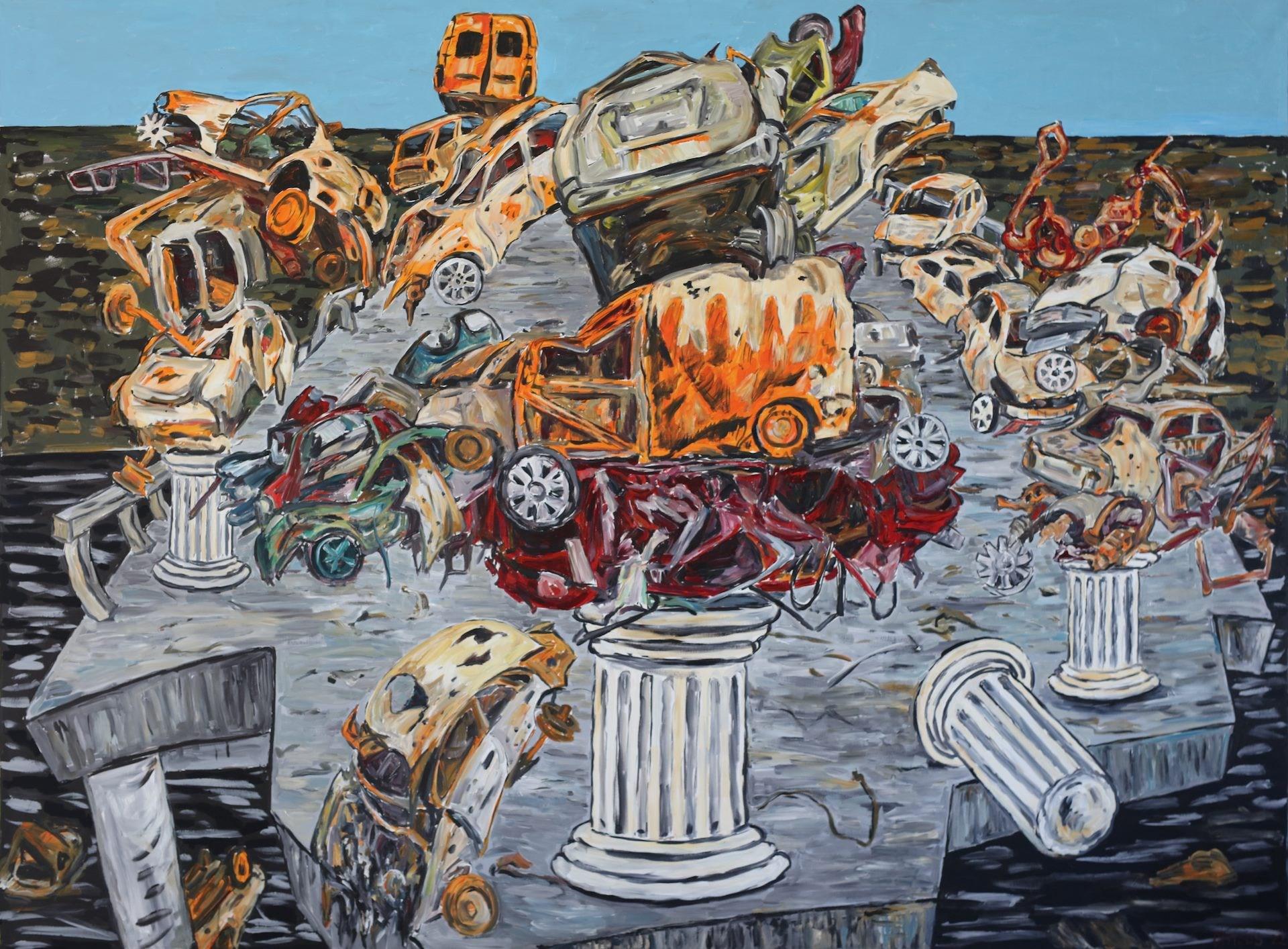


How Our Approach Changed During The Second Period
When we returned the second time, we felt a deeper empathy and needed to find new ways to express this. I had done a drawing titled ‘Small Island’ when working with Ave. It seemed out of place and not to fit with the others. It had popped out of my subconscious and although I did not understand it, it was everyone’s favourite, including Hellen. On the return I realized it represented the way families are forced to huddle together when there are air -raids and missile attacks. They become a small island of love – holding onto one another and waiting until the danger passes. Their brothers, fathers and sons, that are off fighting, are constantly on their minds. It did not worry anyone that the figures on the island are mermaids. I must have been stupid because everyone found this easy to read and ‘got it’ immediately. When I painted it on a wall, below some steps in a park, passers-by all came and thanked me and showed they loved it. It has become my most successful work in Ukraine in terms of local public reaction.
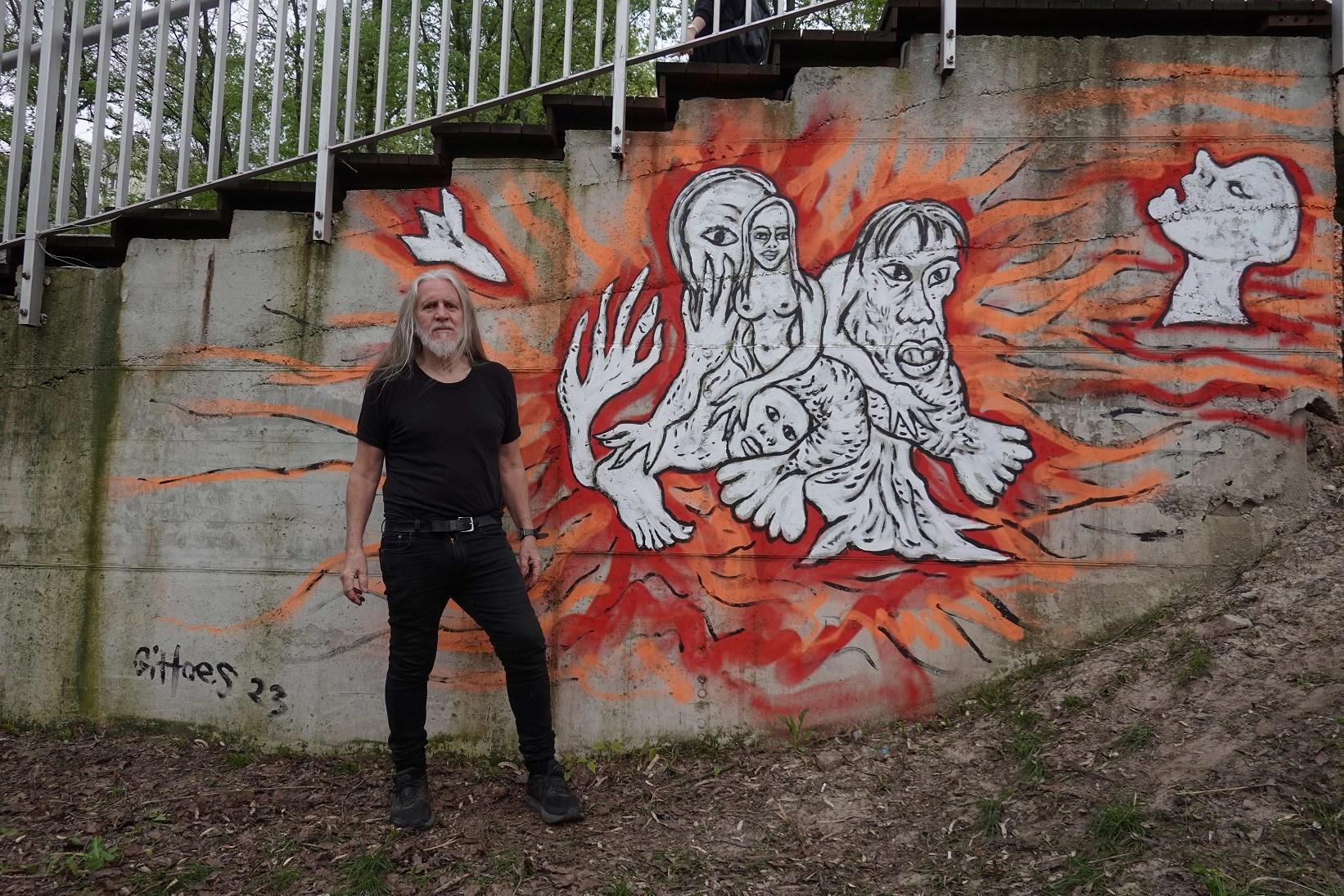
It takes time to come into tune with those living through a war. In the second period we could relate better to what it felt like to be caught up in a war when the next day could be the last, when everything you own can be taken from you in an instant and when the future is completely uncertain. No one can plan anything until war ends. Awareness of this drives Hellen and I to push ourselves past exhaustion when we are in Ukraine and use our abilities to the maximum.
The fact we did not have any contact with journalists and only mixed with locals meant that we did not have our thoughts moulded into a shared ‘outsiders’ perception of the place or events. Any journalist would agree that what we do is very different to what they do. But they admire and understand our contribution just as we do theirs.
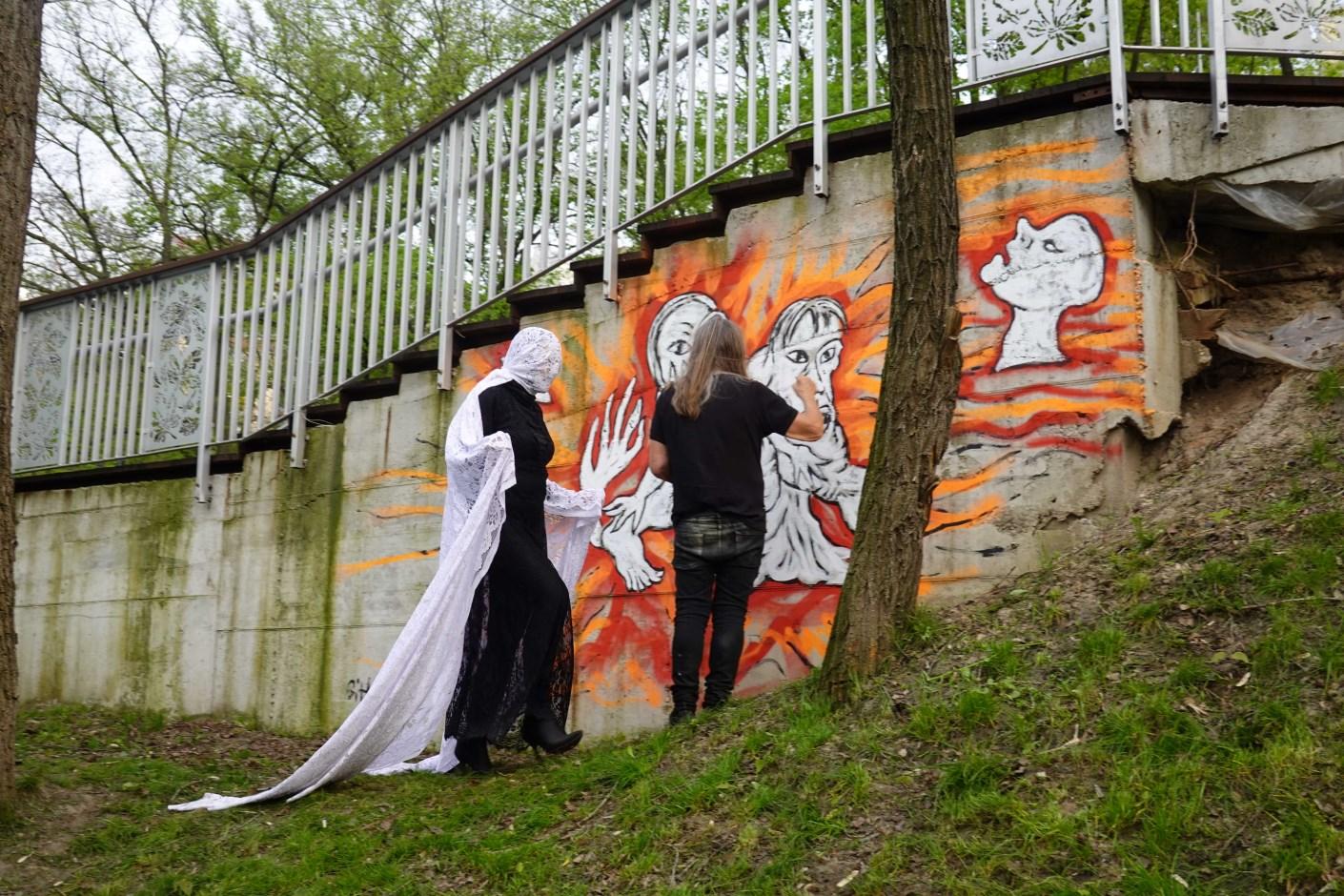

Influences
I spend much more time watching films than reading about artists or visiting great art in museums. Francis Ford Coppola’s film ‘Apocalypse Now’ had a greater influence on the direction my art took than any contemporary painter.
The link to Goya’s late etchings and Black Paintings is always there and has been referenced by almost every writer on my work. Ave brought out the Surrealist in me with her insistence that we try to work as much as possible from the subconscious.
The German Expressionists like Kath Kollwitz, Max Beckmann, Otto Dix and George Groz were some of my earliest influences from as far back as High School. I knew a war in Europe would produce a new group of artists similar to these and hoped to find them and be able to collaborate. Going to Ukraine was like travelling back in a time machine to join with the German Expressionists.
As I point out in the film – Durer’s ‘Night Death and the Devil’ has always been a key influence. There are similarities to the way I draw to Phillip Guston’s drawings, especially the Nixon Series but I did not discover Guston until my own style of drawing had fully formed. My ‘Hotel Kennedy’ series of etchings (conceived in 1969) printed in 1971 demonstrate the early similarity to Guston’s drawings. I have drawn like that since I was a kid and continue to in my old age.
In my lifetime I have been privileged to work with Leon Golub and there are many similarities in our approach and subjects. Also, Nancy Spero and Carolee Schneemann have been significant collaborators sharing the same anti-war message.
Picasso is always a great inspiration and influence and I love the portraits of Modigliani. Whenever I draw in war zones I do it directly from life and Modigliani with his pure line is a great influence. The best example of this is my drawing of the little girl Eva with her cardboard box of memories. Eight year old Eva had her home destroyed and still lives in the ruins next to the House of Art.
Joe Delaney who was the African American artist who I worked with in New York in 1968-9 encouraged me to do street portraits with him of strangers willing to pay a few bucks for their likeness to be done. This was a great start to the spontaneous drawings I do in war zones. (See my drawings from Rwanda, in particular). Joe helped me to lose my inhibitions about asking people to pose and not worrying about their reactions to the way I depicted them.




My Approach
I am greatly opposed to the ‘Jonny One Note’ syndrome of many artists who seek a signature style.
Works like ‘Dead Russian’ and ‘House of Culture’ (interior) are in my EXTERNALIST style developed in Nicaragua in 1986 under the influence of poet Ernesto Cardinale. My most recent painting ‘Wreck of Hope’ is a metaphor similar to the painting of the same name by David Casper Friedrich. They are taken from detailed drawings I make of the subject and in some cases painted on large canvases on the spot. The triptych at Queensland Art Gallery and other works like Party Dress were painted from life and in the living situation but even though subject was close, in a physical sense, I made compositions from the elements that did not fit the exact reality – like the columns in Bridge of Death and making the Party dress fly like a ghost.
Punisher Palace uses spray paint like the Russian Graffiti on its walls and is in a kind of Post Expressionist style unlike the others.
I believe my best painting is ‘Kiss of Death’ which is very Gittoes and I can not think of any similarities to the work of other artists or influences. The most direct input being the actual graffiti of the Punisher Scull (from Marvel Comics) used by the Russians.
I have a different approach to painting when painting outdoors with the subject and when painting in the studio. When outdoors my approach is more literal and reserved as I do not have the equipment to ‘let go’. In Ukraine, it was really inhibiting having to paint in acrylics. I dislike acrylics and have always worked with oils and lacquers. But when doing the outdoor paintings in Ukraine I had to be able to take the canvas on and off their wooden stretcher frames as they would not fit into Kate’s car and we did not have a truck. Oils stay wet and can not be rolled. I will never be completely happy with the finish on these paintings. I find acrylics dull and very inhibiting to work with. The three large paintings in QAG are all acrylic. I would like to repaint them in oils, covering the acrylic but they now have a historic purity having been painted in Ukraine, so, I have to resist going back to them.
I am a lot happier with the finish of the oil paintings I have done in the studio, like Dead Russian, Kiss of Death, Warhouse, House of Culture, Punisher Palace and Flexible – plus the new work in progress ‘Wreck of Hope’ . I made smaller acrylics of all of these in Ukraine along with a lot of drawings which have become my studio studies.


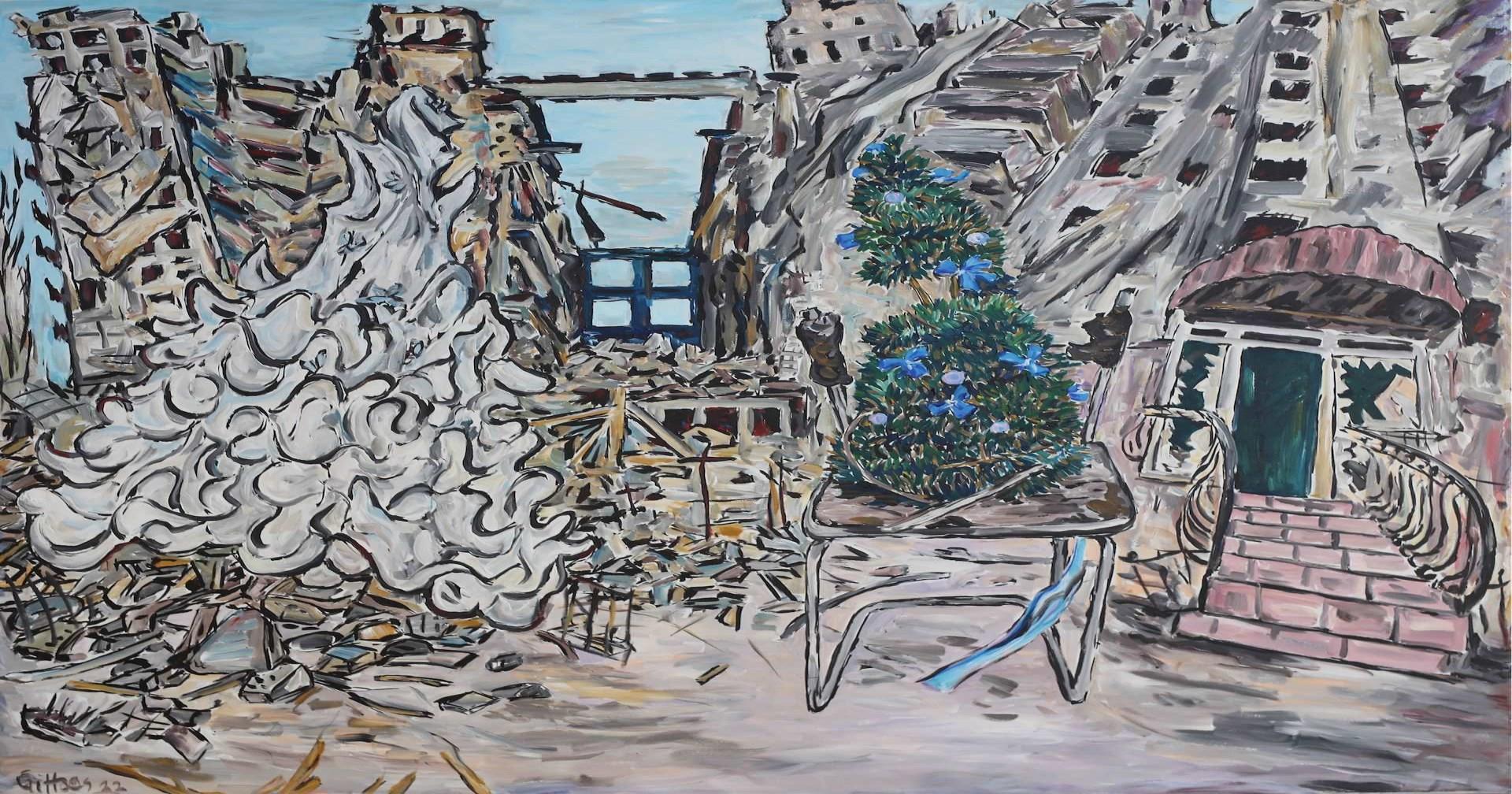

When working in the studio I am like an abstract painter. Once I have put the drawing on the canvas and I then forget about it being figurative and apply the paint and varnishes in a fluid, dancer like way. My methods remind me of Soutine and the De Kooning’s Woman paintings. I get lost in the application of the paint with music playing in the background, my mind is a long way away from the origins of the subject. The application of paint onto the canvas and the subject source become separated. This is what makes my paintings very different to the way social realists painted during the communist eras in Russia and China. Also, very different to Diego Rivera and the Mexican muralists. This application of paint is very personal, textured and gestural. My mother was a ceramic sculptor and experimented with glazes the way I experiment with paint. Getting loose and free with paint brings my paintings closer to the painters I admire and helps me escape the danger of political art. Political art can be closer to illustration than fine art painting. I never want to be caught in that trap.
Abstract Painters appreciate seeing this and are attracted to my work for its ‘painterly’ qualities. They would not relate to it if it were purely illustrative.
Hellen

Hellen is always there working nearby with her performance art. Our two art forms existing in a parallel universe. She regards my painting-in-the-open, available to passers-by, as a form of performance action. There is a strong conceptual element to what we do, especially, knowing our activities are being recorded, often self-recorded, on film/video.
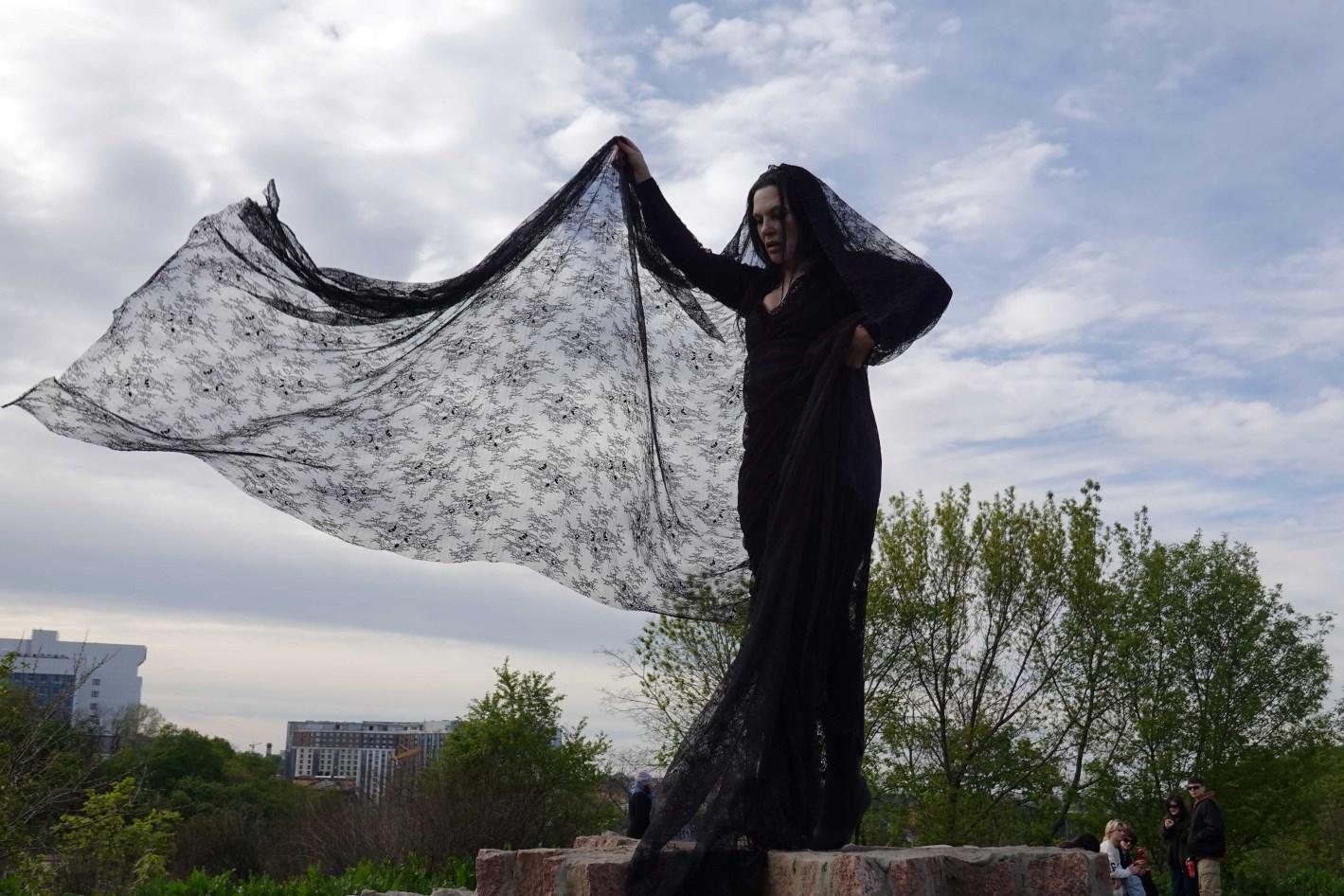

Warhouse
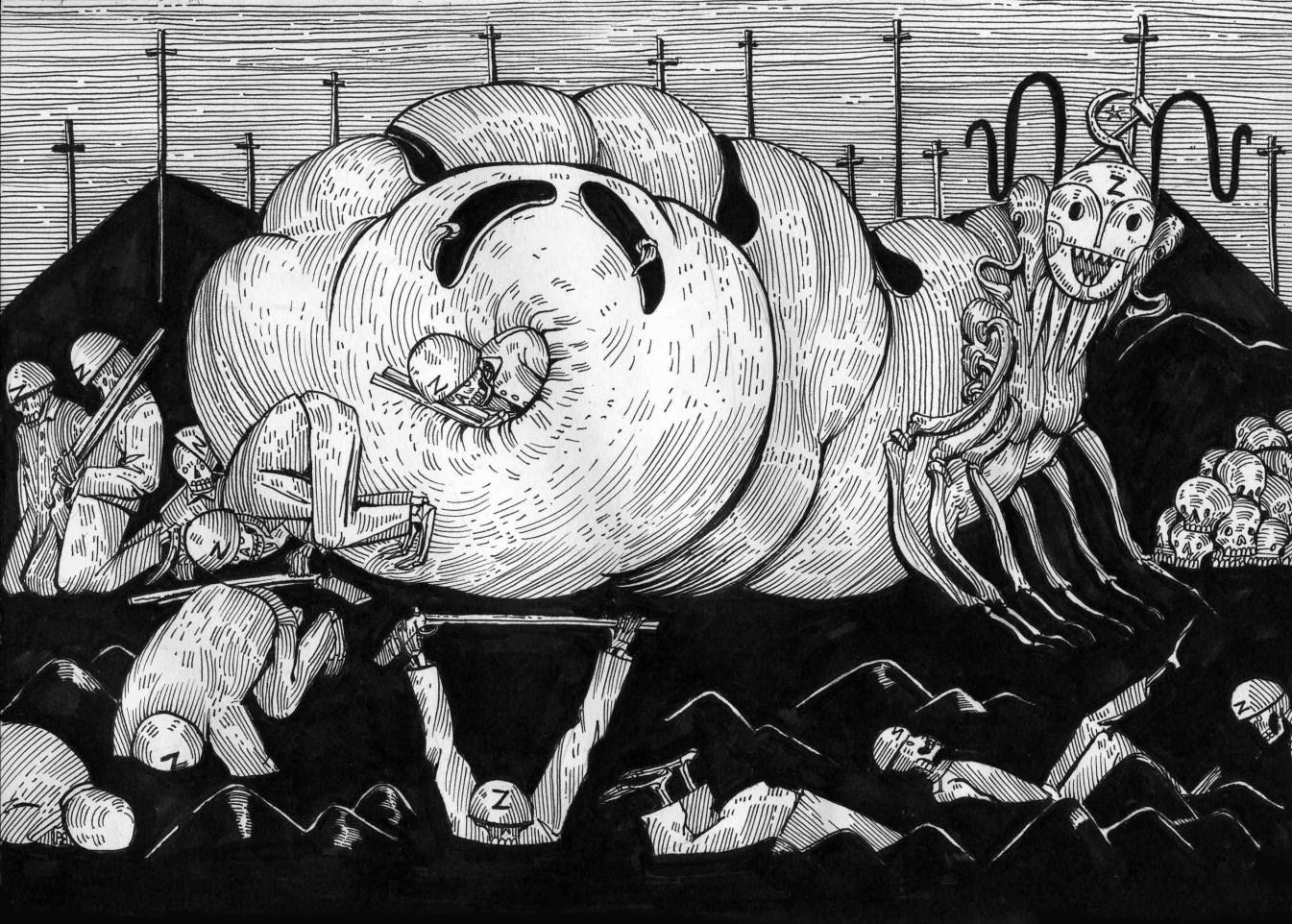
The other important painting, which became incorporated into the large mural at House of Culture, is titled WARHOUSE and alludes to Picasso’s Demoiselles De Avignon. It is in yet another style similar to the Matisse cut outs of dancers.

I am presently painting ‘Wreck of Hope’ based on new drawings of the destroyed Irpin bridge (Bridge of Death). Returning to it I was reminded of David Casper Friedrich’s masterpiece ‘Wreck of Hope’. This destroyed bridge and the massacre that occurred on it, when the Russians killed those families waiting in cars to flee from Irpin to Kyiv, represents the end of the hope the world had that the United Nations could prevent another great war in Europe. When in Ukraine we feel we are in World War Three. The fighting and everything about it resembles old movies of WW2 Europe – it seems like a huge step backwards for humanity.
Visual Diaries
I have always kept visual diaries …. Most of my previous diaries are in the collection of the Mitchell Library (State Library) and a selection can be seen as scans on the Library site. The diaries are a combination of text and drawing along with clippings from newspapers and photographs. What is different this time is that after meeting Ave, I began to follow her practice of doing at least one black and white ink drawing on small paper 18 X 12.5cm. sheets, every day. I have continued this practice and exchange the images daily with Ave by scanning them and sending through email. Ave does the same. It has been the most intense and productive collaboration of my career.
Small Format And The Subconcious
Ave has reminded me of the importance of drawing in a small format. It gives a greater freedom for subconscious expression. When working on larger sheets of paper or canvas there is an inhibiting factor where the output is taken too seriously. Working small is like doing a doodle, there are no inhibitions as the amount of material (paper and ink) being expended is trivial. This may seem strange but it has freed me up to do more drawings that are like those I did when I was much younger and was less restricted by a formal approach to drawing. I regard the small sheets of paper like etching plates (copper or zinc) and it is interesting that with new digital technology they can be scanned and printed to look like etching prints. I am making the prints of our drawings larger than the originals and will be exhibiting them. Ave and I are planning to publish a Graphic Novel using our drawings without text as a subconscious history of the war. At some point we will feel we have a complete visual narrative and can take them to a printer. I discovered Ave by seeing prints made from her work and exhibited in Odessa. The Odessa curator, Uma, had discovered them on Facebook and gained Ave’s permission to show them. (This is explained in the film.) When I first saw Ave’s insect drawing I was startled by their connection to my own imagery and knew that I had to find and meet her. Ave’s insect was like my insect images from the Hotel Kennedy Suite which I created back in 1968-71.

I have continued to use the insect symbol throughout my career. The insect has come to represent people like Putin and Murdock that are so unlike the rest of humanity they are like alien insects.





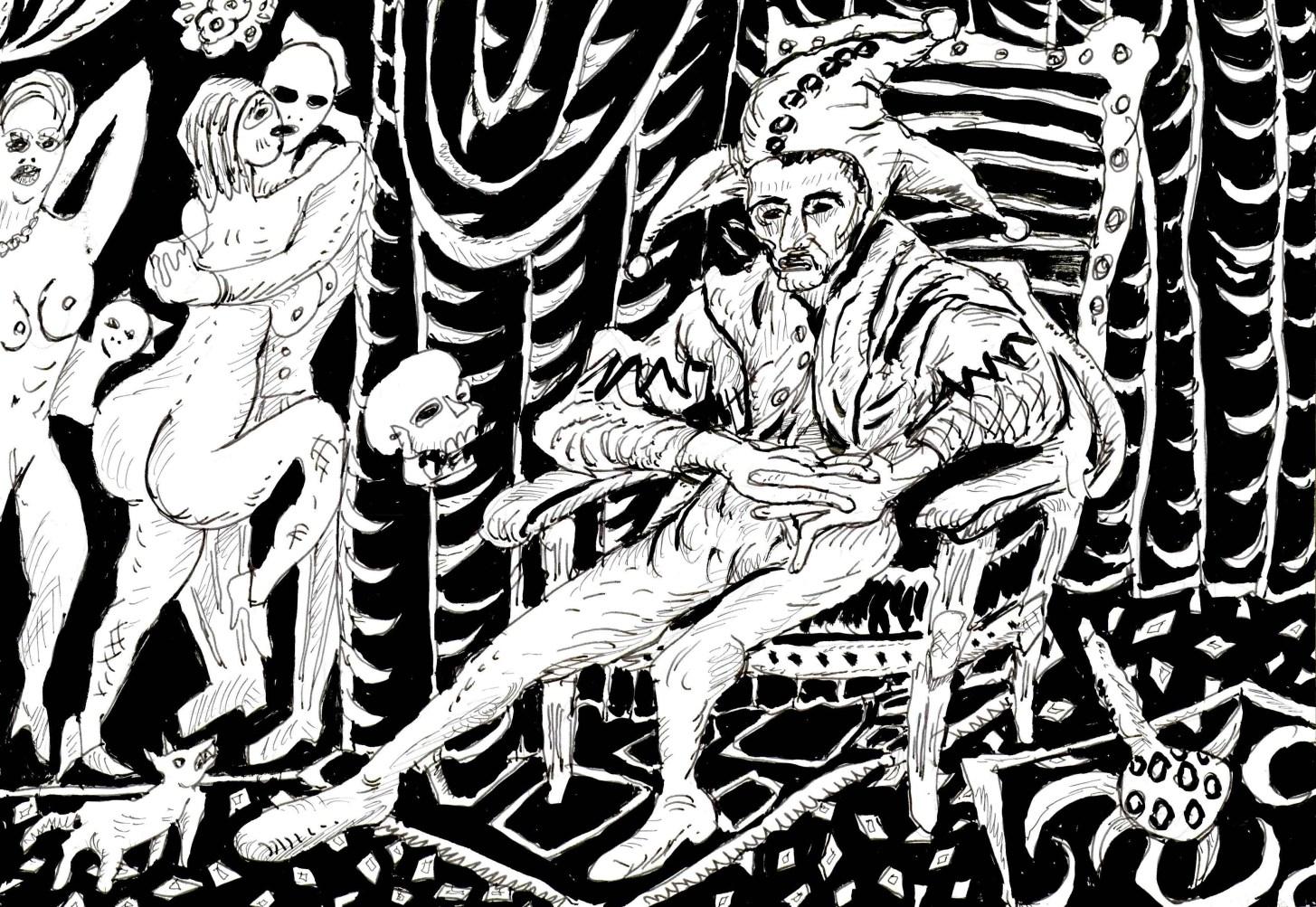


Persistence
Hellen and I have found the best way to slow our brains down to be able to sleep when in war zones is to find a Netflix, Amazon or Disney series and watch an episode when we get back, with our wheels spinning, from an intense day. This is, even, possible in Afghanistan where Westworld helped us through a particularly difficult period.
This time in Kyiv, Ukraine, we stumbled on ‘The Patriot’ a 2015-7 series with Michael Doman playing John Tavner, a troubled unofficial, intelligence officer and folk singer posing as an Industrial engineer. His father runs a private intel company like Black Water and has bungled an operation to frustrate the Iranian development of nuclear weapons. John is given the responsibility to fix it. I have rarely empathised with a character as much as John and learnt something about myself while watching. While I am an artist and have no links to any agency like the CIA my character is disturbingly like John’s. John is able to override personal pain, can pull off physical challenges that others would find impossible, and is doggedly unable to give up on an objective regardless of the risks. John is, also an artist who can translate his experiences into poetic song lyrics.
Hellen, while watching the series in bed, in Kyiv as air, raid sirens blared, outside and rockets exploded in buildings nearby could see the parallel, especially as John’s injuries built, like having his fingers shot off and reattached, and damaging his legs when jumping from a high building but persisted. At one point John is about to enter an Embassy by climbing over 5 electrified fences designed to keep people out. He explains he has a mental strategy that it is all about reaching the step beyond halfway. Once that step is reached it is harder to go back than forward, so it becomes easy to finish. I use similar strategies. When things are really bad I make myself remember all the times I have boarded a plane after the extremes of places like Rwanda, when there were moments the chances of survival seemed slim, and realize that everything passes and what I am presently going through will, also, pass and become a memory. That works.
These days my collective memory of all my wars seems as unreal to me as a TV series. It is as hard for me to believe as it is for those I tell my stories to. New events trigger me to recall old episodes. I entertain my driver with whatever bubbles up as we pass check points and bombed out buildings. It is usually someone like Kate, on a rapid learning curve about who the person they have found themselves assisting. On the way to some horrific encounter like the Bridge of Death in Irpin and I will roll out stories of other front-line excursions. It prepares the mind. Like the John Tanner character, I recruit non-professionals to assist, who have no previous experience with war conditions.
Hellen and I returned from Ukraine fried, completely exhausted. Hellen found a series titled ‘The Old Man’ starring Jeff Bridges – an actor of about my age, who, people say, looks a bit like me. Jeff plays a former CIA soldier who joined with Afghans thirty years earlier during their war with Russia and has had to go into hiding because he did something that makes his former employers want to kill him. It is strange watching Jeff’s flashbacks to when he was in Afghanistan and comparing them to my real experiences there.
I have been meeting with Taliban and have gained a permit to film without minders or surveillance as well as getting their blessing to buy a house and set up a new Yellow House Creative Centre and school. The Taliban of 2023 are much more dangerous than the Afghans that were fighting the Russians that Jeff’s character is imbedded with. I am the person who made ‘Miscreants of Taliwood’, a film that could not be more critical of the Taliban, resulting in death threats being delivered to the Australian Embassy in Islamabad offering to ‘Remove my face from my body along with my head’. Recently, back in Jalalabad, I went to a meeting with the hard liners of Taliban Military High command. I am not sure if it was an intentional strategy to test me, but they included a notorious killer, whose aura was darkened by a history of inhuman violence. He was determined to provoke me. His hand was bandaged after doctors had tried to restore a few fingers from a bullet wound. He let me know he had a grudge against foreigners due to being imprisoned and tortured by the Americans for three years. He thought it would be easy to scare the shit out of me, but I made jokes and told him I needed someone like him by my side and that he should leave the Taliban and work with me. I would love to see Jeff Bridges play that scene.
WHAT IS NEXT?
Hellen and I have promised to keep returning to Ukraine until this war ends. This commitment means we are stretched between our sustaining Yellow House activities in Jalalabad, Afghanistan and Ukraine.
We have only just returned from Ukraine a second time and will be leaving in a few weeks for Afghanistan. We have purchased a house in a tribal area outside Jalalabad where we are building a safer Yellow House beyond the influence of Taliban and away from the threat of attack by ISIS. We have permission to hold classes, including those for girls and women at the new Yellow House. Also, permission to film anywhere without minders or surveillance. We have put both of these permits to the test successfully.
Afghanistan has a common history with Ukraine as it was invaded by Russia and two million people were killed by the Russians.
- George Gittoes © 2023.














